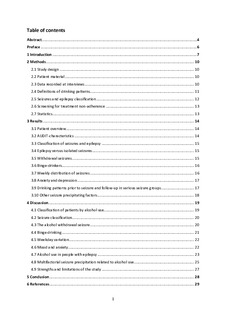| dc.description.abstract | Purpose:
The aim of this study was to investigate the relationship between alcohol use and seizures in acutely hospitalized patients, both isolated seizures as well as in diagnosed epilepsy. We wished to study the extent of the problem as well as the clinical characteristics of people with alcohol-related seizures in various seizure disorders, including their drinking pattern.
Method:
In this prospective observational case cross-over study, a semi-structured interview took place after admission in 134 consecutive patients (epilepsy 92, isolated seizures 42). Alcohol use was assessed by the Alcohol Use Disorders Identification Test (AUDIT) and daily alcohol unit consumption was recorded during the six days prior to the seizure. Sleep-time was recorded for the last three dates. The Hospital Anxiety and Depression Scale (HADS) was also applied. In 30 patients with epilepsy, non-adherence was assessed by therapeutic drug monitoring (TDM) at admission compared to a routine drug concentration/dose (CD) ratio when no seizure had occurred. C/D ratio <50% at admission was defined as non-adherence.
A follow-up telephone interview (alcohol intake/sleep) covering the same weekday was performed on a seizure-free day at least four weeks later.
Results:
28% of patients had AUDIT score ≥8 (hazardous drinking), 22% in epilepsy, 43% in isolated seizures (p=0.012). Alcohol consumption, non-focal seizures and HADS anxiety subscores were increased in isolated seizures, suggesting a withdrawal mechanism. A high percentage of binge drinkers had epilepsy (61%). In the 58 epilepsy patients with social drinking (excluded hazardous drinking/binging>10 units in one day), the alcohol intake was not different prior to seizure compared to follow-up, downgrading the role of modest alcohol intake as a seizure precipitant in epilepsy. However, in 10 of the 19 patients with idiopathic generalized epilepsy (IGE), binge drinking had occurred within the last two days prior to seizure.
Sleep loss prior to the seizure was associated with hazardous dinking. Non-adherence was present in 13 of 30 patients with TDM; 8 were hazardous drinkers (75%). In the 22 with AUDIT<8, non-adherence was present in 7 (32%) (n.s.).
Conclusion:
Alcohol is a major seizure precipitant in the context of hazardous drinking and withdrawal. Occasional social drinking in people with predominantly focal epilepsy is an uncommon cause of seizure breakthrough, but binge drinking prior to seizure admissions in IGE is common. In people with epilepsy, alcohol, sleep loss and non-adherence often occur in combination prior to a seizure. Alcohol alone should not always be blamed. | nb_NO |
